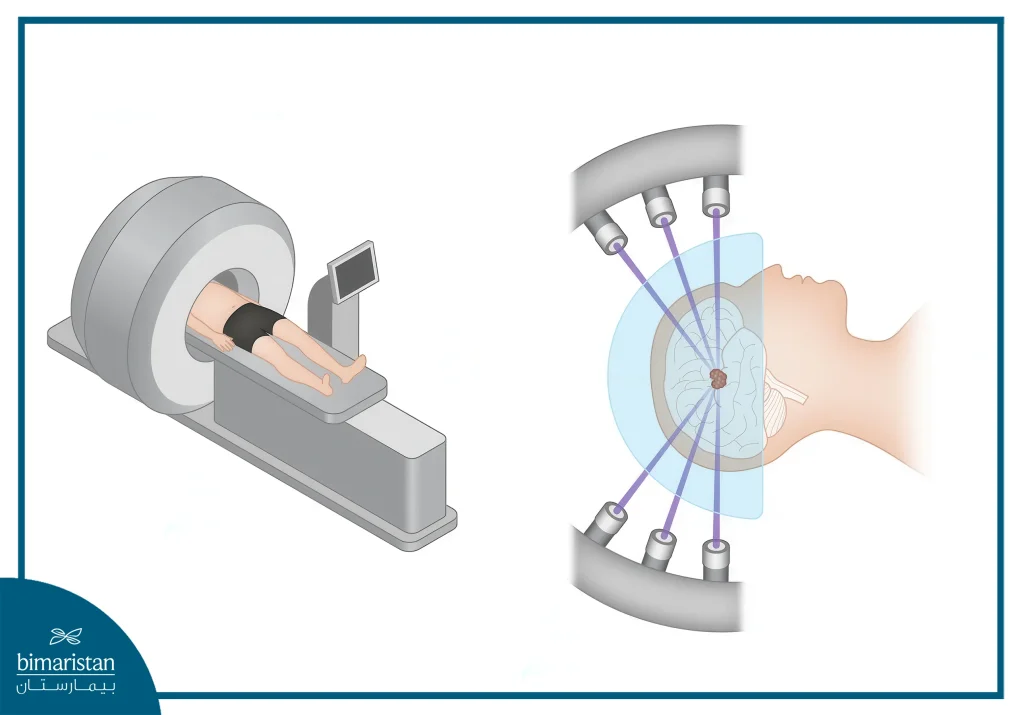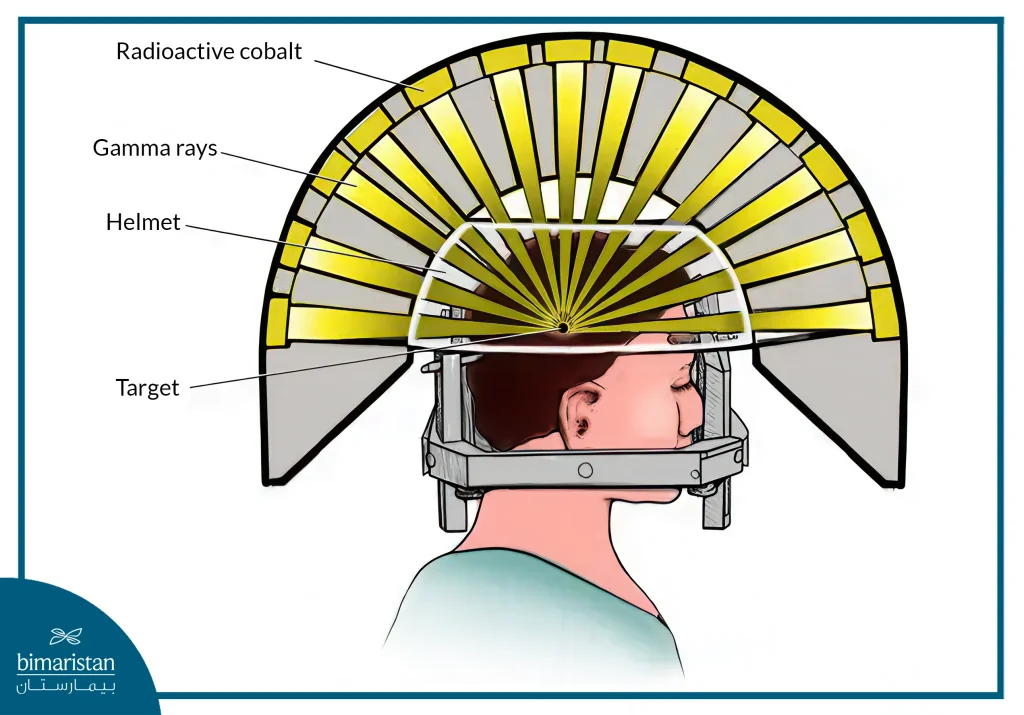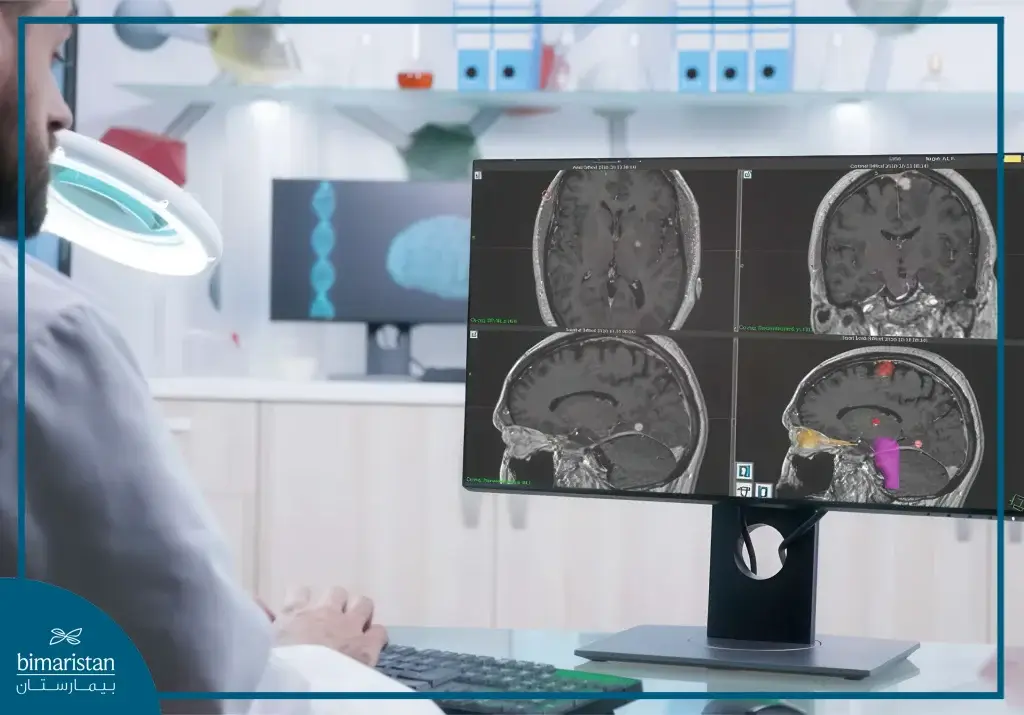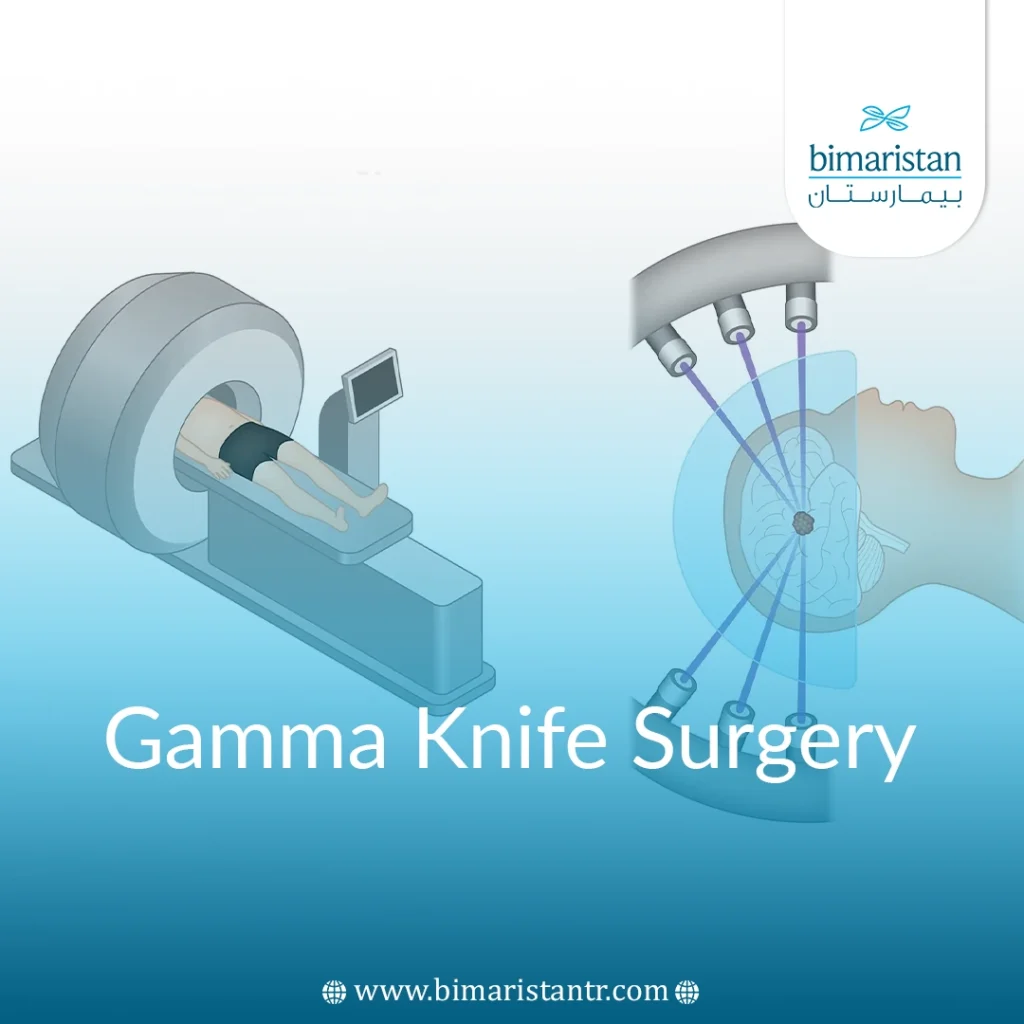What is Gamma Knife surgery?
Gamma Knife surgery is a treatment method that uses radiation and computer-guided planning to treat brain tumors, blood vessel abnormalities, and other abnormalities in the brain. Despite its name, this procedure does not involve any incisions, not even an incision in the skin.
Gamma Knife is actually a treatment that delivers highly focused beams of radiation. About 192 “beams” of radiation converge and focus precisely on the targeted area of the brain, specifically the tumor or lesion, while sparing the surrounding normal tissue.
Gamma Knife surgery is also known as stereotactic radiosurgery, Gamma Knife radiosurgery, and Gamma Knife radiation.

What conditions does Gamma Knife surgery treat?
Gamma Knife surgery can treat many brain disorders, including:
- Brain tumors (both malignant and benign): These tumors include brain metastases, pituitary tumors, pineal tumors, craniopharyngiomas, meningiomas, chordomas, chondromas, and gliomas.
- Acoustic neuroma: A non-cancerous tumor that develops around the balance and hearing nerves that connect the inner ear to the brain.
- Arteriovenous malformations (AVMs): These are abnormal tangles between blood vessels.
- Tremor: Tremor due to conditions including essential tremor or Parkinson’s disease (a nervous system disorder).
- Trigeminal neuralgia: A persistent condition that affects a specific nerve in the face, causing severe pain.
- Some types of epilepsy.
Gamma Knife may be useful if you have a brain tumor that traditional surgical techniques cannot reach or if you are unable to undergo surgery due to your condition or age.
It can also be combined with traditional surgery to prevent tumor regrowth. Gamma Knife is also used in some cases that require urgent treatment.
Surgery details
What happens before Gamma Knife surgery in Turkey?
Medical review
- Your neurosurgeon will gather your medical history and perform a complete physical examination, and you may undergo additional tests.
- Tell your doctor if you have a pacemaker, aneurysm (brain) clamp, ventricular assist pump, implanted nerve stimulator, metal implant, metal from wounds, cochlear implant, spinal stabilization devices, severe lung disease, or GERD or are unable to lie on your back for 30 to 60 minutes.
- Also, tell your doctor if you are allergic to any type of medication, latex, tape, contrast dyes, iodine, or general or local anesthetic agents.
Eating, drinking, and medications
- Do not eat or drink anything after midnight the evening before the procedure (for AVM procedures only).
- Take morning medications with sips of water on the morning of treatment (after advice from your doctor).
- Bring all prescription and over-the-counter medications with you.
Hair and clothing preparation
- Wash your scalp the night before the Gamma Knife.
- Lift your hair up. Do not use clips, pins, or bands; your head will not be shaved.
- On the day of the procedure, wear easy-to-wear shoes, comfortable pants, slacks, a skirt or shorts, and a button- or zipper-front shirt with short or loose sleeves. Do not wear a shirt that you must put on/off over your head.
Driver
A family member or friend will need to pick you up on the day of the procedure and drive you home after treatment. They don’t necessarily need to stay in the hospital during the procedure itself.
How is Gamma Knife surgery performed?
Gamma Knife treatment involves several steps; the initial steps differ if the Gamma Knife system uses a rigid external head frame or uses a frameless mask. If a head frame is used:
- First, a box-shaped head frame is placed on your head. Made of aluminum and weighing less than two pounds, the head frame serves as a “frame of reference” in treatment planning and is essential in keeping the target perfectly aligned during precision therapy.
- You will receive four injections of local anesthetic, one on each side of your forehead and two at the back of your head; these are the areas where special pins are placed to attach the head frame to your skull.
- You may feel pressure as the screws are tightened, but this usually only lasts for a few minutes. After the head frame is placed, the radiation therapist will take measurements of your head.
- An imaging test, such as a CT scan or MRI, is usually done with the head frame in place.
These measurements and scans are used to plan your treatment.
Frameless Gamma Knife systems use a thermoplastic mask that is placed on your face. The mask is then secured to a frame on the Gamma Knife table so that your head is completely stationary.
These remaining steps are the same for both frame-based and frameless systems.
- An intravenous catheter may be inserted into your arm to inject radioactive material or a contrast agent (a type of dye) for computed tomography (CT) and/or magnetic resonance imaging (MRI), as these scans and the dye determine the exact location, size, and shape of the tumor or lesion.
The scan usually takes about 30 minutes to complete. - An intravenous catheter may also be used to deliver a small amount of anesthesia to help you relax (if needed). Most patients remain awake but under light anesthesia during the procedure. Under certain circumstances (usually in children), general anesthesia is used.
- Based on the results of the scans and other information, your neurosurgeon, radiation oncologist, and other team members will fully plan the treatment method on a computer. They will decide the area(s) to be treated, the dose of radiation, and how to target the lesion for the best results. You can stay in your room with family or friends during this time. Plan to spend several hours, up to 12 hours, at the treatment center. Your treatment team will give you a more accurate estimate based on your condition.
- Next, your treatment begins. Your head frame or frameless mask is attached to the space of the Gamma Knife table you’re lying on so that your head doesn’t move during treatment. The Gamma Knife table moves slowly to the Gamma Knife machine that delivers the radiation. The treatment team will be immediately outside the room while you receive treatment, but cameras will constantly monitor you. There is a microphone near your head so you can easily talk to the staff during treatment.

- Most treatments take from 30 minutes to three hours (for the same treatment), depending on the size, shape, and location of the lesion and the number of radiation doses.
- After treatment, the table moves out of the machine, and the staff enters the room. The head frame/mask and IV catheter are removed.
Depending on the type and size of the tumor or lesion, more than one treatment session may be needed. Your neurosurgeon and/or radiation oncologist will review your treatment plan with you.

How will I feel during the Gamma Knife procedure?
The actual treatment with the Gamma Knife is painless.
There is no heat or noise, and you will not feel any discomfort during the treatment.
You can listen to music or take a nap during the procedure.
What happens after Gamma Knife?
- Your head frame is removed (if you have a rigid outer head frame), the pin sites are cleaned, and antibiotic ointment and bandages are applied.
- If you have a headache, nausea, or vomiting, you will be given medication.
- Staff will review the discharge instructions with you and your companion, and you will be monitored for 30 minutes to one hour before you are discharged from the hospital.
- Keep your head elevated on two pillows for one week; this helps reduce swelling at the pin sites (if you have an external head frame) and pressure inside your head.
- You can wash your hair/scalp 48 hours after surgery. This allows the pin sites to start healing and prevents infection from developing in the wounds.
- If you experience discomfort, you can take non-aspirin pain relievers such as ibuprofen (Advil, Motrin) or acetaminophen (Tylenol).
- You can remove the bandages from the pin sites the morning after the procedure, and clean the sites twice daily with hydrogen peroxide or mild soap and water.
- You can then apply a small amount of antibiotic ointment such as Neosporin or Bacitracin to the pin sites for three to four days. It’s enough to apply bandages to the pin sites for two to three days.
Potential Risks of Gamma Knife Surgery/Benefits
What are the risks and/or side effects of Gamma Knife surgery?
While the risks associated with the procedure are typically low, the risks and/or side effects of Gamma Knife surgery may include:
- Brain swelling
- Headache
- vomiting and nausea
- Numbness/tingling sensation in the scalp at the pin placement sites
- Hair loss (sometimes only if the tumor is close to the scalp and the hair follicles are irradiated)
- epileptic seizures
- Hemorrhage (bleeding in the brain)
- Feeling tired
What are the benefits of the Gamma Knife procedure compared to traditional surgery?
There are several benefits of Gamma Knife surgery over traditional surgery.
Gamma Knife surgery:
- No incisions or general anesthesia are required.
- It can target tumors/lesions deep in the brain that cannot be safely accessed through traditional surgery.
- It can target multiple tumors/lesions at the same time.
- It avoids the risks and complications of other surgery (such as bleeding and infection from the incisions).
- Limits damage to surrounding healthy tissue.
- It results in little discomfort or pain after treatment.
- It is usually performed as an outpatient procedure (rarely requiring an overnight stay).
- A return to normal activities is allowed in a day or two.
- It usually doesn’t require physical therapy or other rehabilitation.
Recovery and outlook
What is the prognosis after Gamma Knife surgery?
The success of the Gamma Knife procedure depends on the size, location, and type of the lesion, your personal medical history, and other factors. Before treatment, discuss your hopes and expectations with your neurosurgeon and radiation oncologist.
The goal of Gamma Knife surgery is to stabilize or shrink the cancer or destroy the tumor or lesion. Depending on your condition, you may or may not need additional Gamma Knife treatment or traditional surgery. You’ll have follow-up CT and/or MRI scans to check your treatment progress.
It can take weeks, months, or a year (or sometimes longer) to see the full effects of treatment. For example, pain relief if you have fifth nerve pain can occur anytime between one day and six months, with most people improving within one month.
Cancerous tumors usually become stable or shrink over weeks to months. Many noncancerous tumors stop growing immediately (the main goal), but they may not get smaller. Arteriovenous malformations may take two to three years to resolve after treatment.
Cost of Gamma Knife surgery in Turkey
The cost of Gamma Knife radiation varies depending on the size of the tumor and the number of sessions it takes to treat the brain tumor. However, most patients are treated in one session. In general, Gamma Knife surgery is cheaper than traditional open surgery in removing the tumor.
Many brain tumor patients from all over the world visit Turkey annually for Gamma Knife surgery, due to the confidence of these patients in the specialized and well-trained Turkish medical staff to perform such operations at relatively cheap prices, in addition to the health and service development witnessed in Turkey’s hospitals in general and Istanbul in particular, and the presence of employees who speak English and Turkish fluently, which facilitates the process of communication between the doctor and the patient.
The price of a Gamma Knife session in Turkey starts from 3 thousand US dollars, which is much lower than the price in Western countries; the cost of a Gamma camera in the United States is 10 times this value!
When should I call my doctor after the Gamma Knife procedure?
Call if you feel or notice any of the following symptoms:
- Feel the heat when touching the pin locations (if you have the external head frame).
- Leaking, cloudy, or foul-smelling oozing comes from pin locations.
- You have a fever of 101 degrees Fahrenheit or higher.
If you experience nausea, vomiting, severe headache, vision changes, difficulty speaking, seizure, or any other symptom that is unusual for you, call your doctor immediately or go to the nearest emergency room.
Note
Gamma Knife is a highly effective treatment with minimal or no associated side effects due to its ability to stabilize or reduce the size of a tumor or lesion. Often, only one treatment is required; however, Gamma Knife can sometimes be repeated safely and successfully.
The results reported by Gamma Knife centers are usually as good as can be achieved using other techniques, with lower complication rates.
Trial of Gamma Knife surgery for primary trigeminal neuralgia
A total of 100 patients with trigeminal neuritis were treated and followed for a minimum of 12 months.
Studies on Gamma Knife
Some studies suggest that colon cancer patients have a good prognosis for life, increasing life expectancy if performed early.
Sources:
- Penn State Health
- Johns Hopkins Medicine
- UCSF Health

